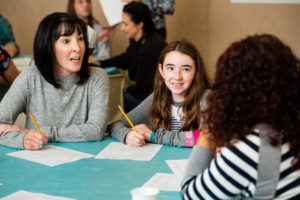
Moving Traditions is adopting the term b-mitzvah in place of b’nai mitzvah in all of our materials, including changing the name of our program to the “Moving Traditions B-Mitzvah Family Education Program.” This decision is based on an emerging understanding of gender fluidity and our respect for the need to continually refine our offerings so that all people feel seen and embraced by Jewish life.
Moving Traditions was created with the understanding that Jewish people and practice will thrive as Judaism continues to evolve—as it always has—to meet the changing needs of Jewish people.
Today, the categories of “bar” (son), “bat” (daughter), and even “b’nai” (masculine plural of “children”) fail to capture the lived experiences of gender beyond the binary. We see a growing number of Jewish preteens challenging traditional gender conventions held by Judaism and Jewish communities.
In support of these preteens and of the inclusivity that they call on us to model, Moving Traditions is updating our terminology in our curriculum and in all of our materials from “b’nai mitzvah” to “b-mitzvah” (or B-Mitzvah when capitalization is required) as our default for the traditional Jewish coming of age ritual.
We believe that b-mitzvah can serve as an inclusive Hebrew abbreviation that alludes to the multiple gender-specific terms already coined. In addition, the term b-mitzvah carries the meaning of “to be engaged in a mitzvah,” recognizing the new state being attained as children take on increasing responsibilities.
Furthermore, placed before the word “mitzvah,” the Hebrew letter “bet”—the first letter of the Torah—signifies the centrality of learning to this ritual. The letter “bet” also signifies home (bayit). The Moving Traditions B-Mitzvah Family Education Program aims to support preteens and their families in the active construction of Judaism and Jewish community as a home, over the years of adolescence and beyond.
As we work to update our materials, website and curricula, which may take some time, we thank you for your patience and understanding of this evolution in terminology, which honors the experience of Jewish youth and their families, and the need to move our traditions in order to keep them “moving” and meaningful.